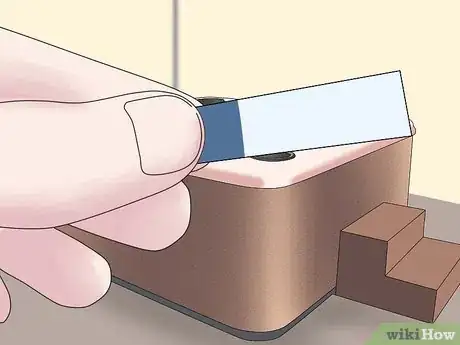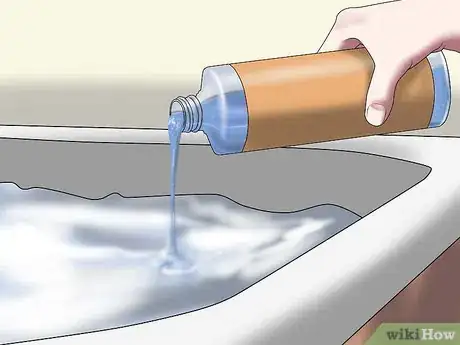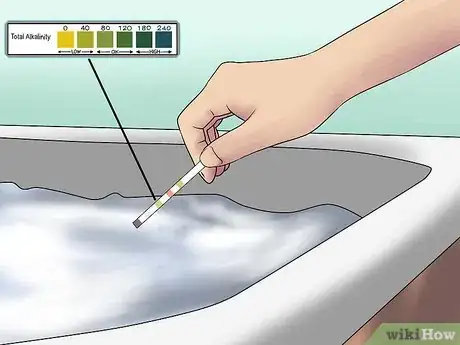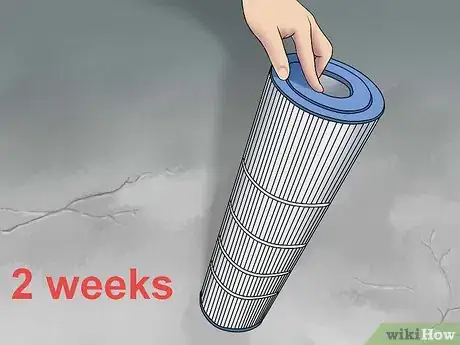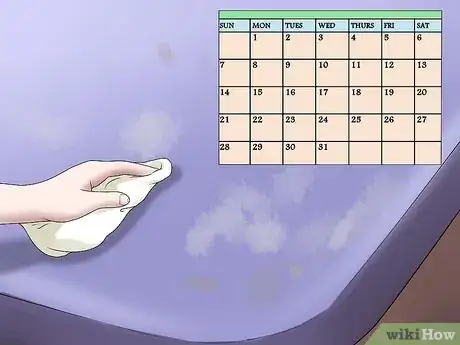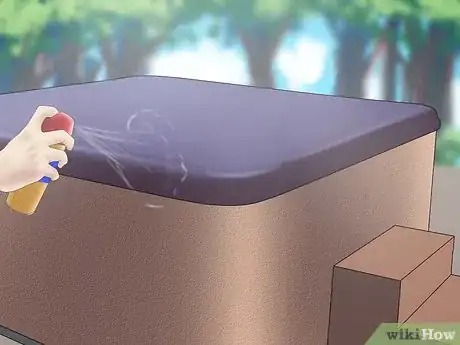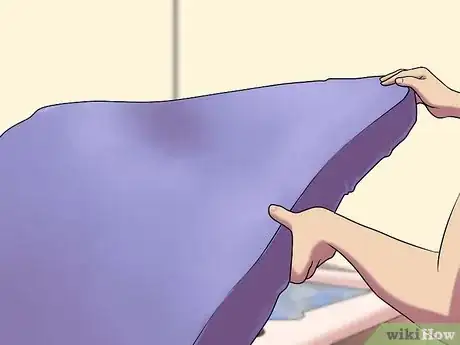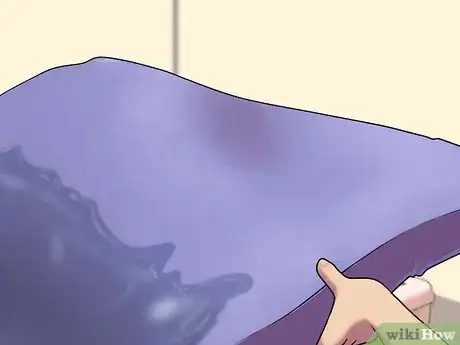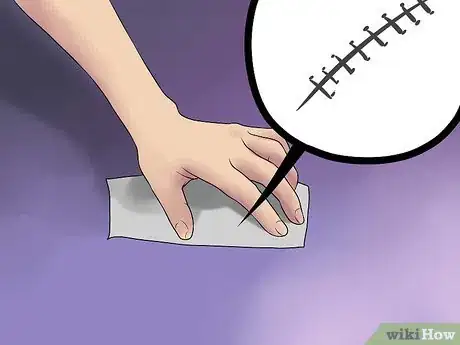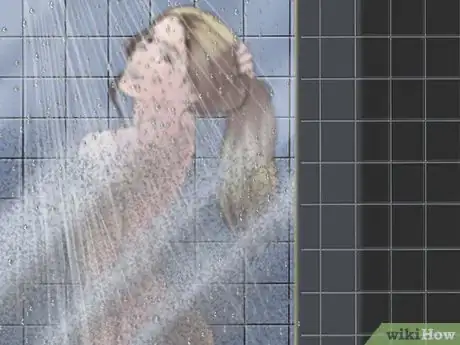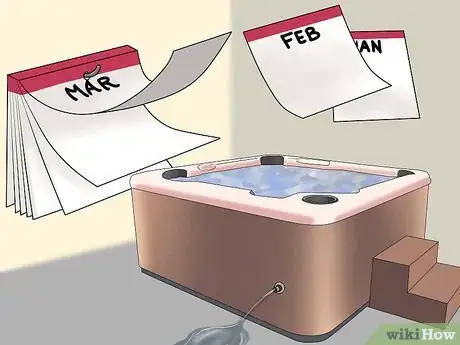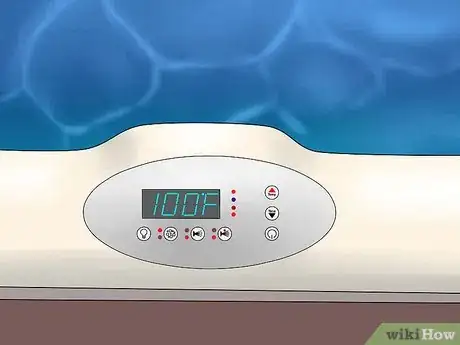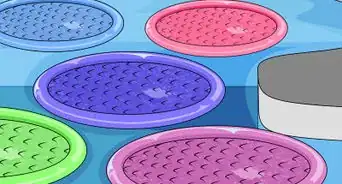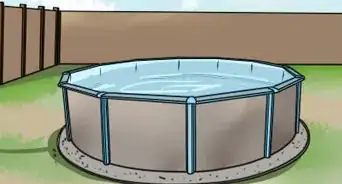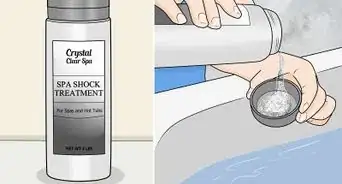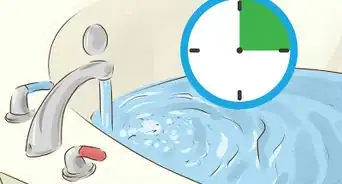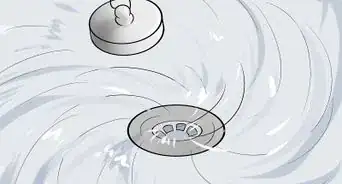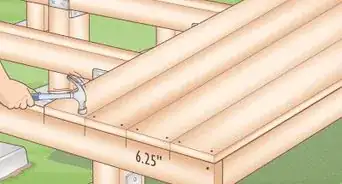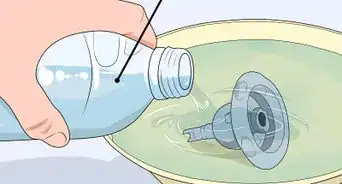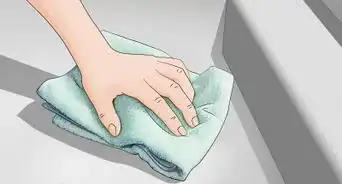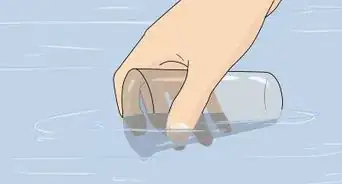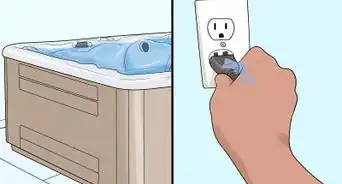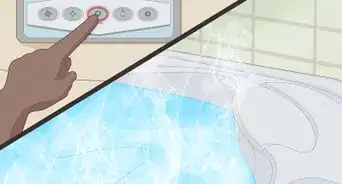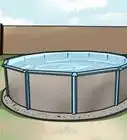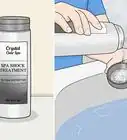wikiHow is a “wiki,” similar to Wikipedia, which means that many of our articles are co-written by multiple authors. To create this article, 33 people, some anonymous, worked to edit and improve it over time.
wikiHow marks an article as reader-approved once it receives enough positive feedback. This article received 28 testimonials and 96% of readers who voted found it helpful, earning it our reader-approved status.
This article has been viewed 801,556 times.
Learn more...
Taking care of your spa is simple and important to keeping your water clean and the spa running well. Good spa maintenance involves regularly cleaning the cover and filter of your spa and checking the chemical levels and adding the right chemicals as needed. It is especially important to maintain the right chemical levels in your hot tub because your spa equipment will corrode if the chemical levels are too high and bacteria can take over if the chemical levels are too low. Simple cleaning for your cover clean, as well, will help keep your spa working better longer and protect from bad bacteria and germs. Overall, regular attention to your spa maintenance will keep your hot tub water sparkling and inviting for all bathers.
Steps
Testing and Applying Chemicals to Your Spa
-
1Use test strips to check the chemical and mineral levels in your spa. You should be checking and adjusting the chemical levels in your spa 1-2 times a week. You can buy spa test strips from most department stores or from a spa store. Packages of these strips cost around 7 dollars, and some test strips provide 6-in-1 readings, including total alkalinity, calcium hardness, chlorine, pH, bromine, and total hardness. Put these strips in your spa for as little as 15 seconds and then view the results.
-
2Add one chemical to your spa at a time. When adjusting hot tub chemical levels, add one chemical to the water, and then wait a full two hours before adding another chemical. This will allow the chemicals to disperse naturally and will help to maximize their effectiveness. Waiting also minimizes the risk of a chemical reaction between the additives that can cause problems.
- Keep your spa cover off for at least 15 minutes after you have added your chemicals. [1]
- Keep your spa water running when you add the chemicals. This is important because you want the jets to mix the chemicals in the water well.
- Pre-measure your chemicals before you add them to your tub. Be careful not to heap the chemicals into your tub, you want to make sure you are achieving the right balance by measuring the chemicals before adding them.
Advertisement -
3Check total alkalinity first. Depending on the test reading, add sodium bicarbonate (spa up) or sodium bisulfate (spa down) as needed. Use your test strips- a well-balanced spa should be between 80-120 PPM in total alkalinity. If the total alkalinity goes above 120, you should add sodium bisulfate (spa down). If the test strip reads below 80, add sodium bicarbonate (spa up). Add these fast-dissolving spa products to your spa, and then recheck your alkalinity in a couple of hours. It is important to maintain your alkalinity first because it affects your pH.[2]
-
4Use chlorine or bromine to sanitize your hot tub. Make sure to use test strips to maintain the correct chemical levels. Chlorine is the old standard for sanitizing your spa; however, it has been largely replaced by bromine because bromine is less harsh and has a less potent smell. chlorine can be purchased in granular form or in 1-inch tablets. You can only buy bromine in 1-inch tablets.
- If you are using chlorine, put 2 tablespoons (29.6 ml) directly into your spa water every other day or as recommended so that the chlorine level stays between 1.5-3 PPM.[3]
- If you are using bromine, the read on the test strips should stay between 3.0-5.0.
- Buy a floater for bromine or chlorine tablets. You will load 4-6 tabs into the floater, and they will dissolve in your spa over time. Using the floater, you won’t have to add bromine or chlorine to your spa as often; however, continue using the test strips to check the chemical and mineral levels in your spa once a week.
- Do not over sanitize your spa with chlorine. Make sure you put the appropriate level of chlorine in your spa, but do not add more than the recommended amount, because it could damage the spa's equipment and cover.
- Consider adding a mineral-based purifier to reduce the amount of chlorine or bromine you have to use. Nature2 makes a product called Zodiac that reduces the amount of chlorine you have to use to maintain your spa.
-
5Check for calcium hardness. The best way to keep the calcium hardness in your spa in check is to use soft water in your spa. If your spa has too much calcium hardness, it will cause scales to form in your spa. You can use a spa defender product to protect against these scales. On the other hand, if your spa does not have enough calcium hardness, the water will start to draw minerals from other sources, like the aluminium or iron in your equipment. In this case, use a calcium booster to balance the calcium hardness in your spa. [4]
- Calcium hardness should stay between 100-250 PPM if the spa has an acrylic finish and 250-450 if the spa has a plaster finish.
-
6Check the pH levels last. Add sodium bicarbonate (spa up) or sodium bisulfate (spa down) as necessary.[5] Your pH should stay between 7.2-7.8. If the pH is off, first work to stabilize the total alkalinity. Then make sure you have added the proper amounts of chlorine/bromine to your spa. And then if the pH is still off, add spa up/spa down or a pH balance product to your spa pH level.
- Your pH levels may be adjusted if: the sanitizer you use is not working well, your spa has cloudy water, scales have developed on your filter, or the water is causing skin and eye irritations.
-
7Shock your spa. Put an odorizer into the water once a week, especially when there have been a lot of bathers using the spa. Odorizers kill the bather waste in your spa and keep the water clear and clean. Use Ozone as a shock treatment if you use mineral sanitizers. Use chlorine or bromine shock treatments, depending on which sanitizer you are using in your water, to shock your water once a week as well.
Cleaning Your Filter and Cover
-
1Clean the filter every two weeks. To unclog and clean your spa filter, take the cartridge out of the filter. Using a hose, run water over each pleat in the cartridge and clean any dirt and foreign matter out of the filter. Make sure to let the cleaned filter air dry completely before putting it back in your filter.
- Replace the spa filter when it has become damaged or has stopped working. You’ll know this is the case when the filter quickly become dirty again after you have cleaned it.
- If you are cleaning your filter cartridge in a dishwasher, be sure to turn off the built-in water heater. Water over 140 °F (60 °C) can damage the filter.
-
2Use a granular filter cleaner for your hot tub, like Power Soak or Eco Soak, to clean your filter every 3-4 months. Also use the cleanser on your filter every time you replace the water in your tub. Replace the dirty filter with a new, clean filter while your dirty filter is being cleaned. Clean out the filter with a hose, soak it the solution overnight, or following the instructions on the cleanser, and then let it dry it completely before putting it back into your filter.[6]
- The least expensive filter cleaner is TSP - TriSodium Phosphate. This is the main ingredient in many dishwasher detergents. You can use one cup TSP with five gallons of water to make a cleaning solution for your filter.
-
3Clean your hot tub cover once a month. The first step to maintaining a clean spa is keeping the cover in good working order because it does the majority of the work to keep your spa clean. Before you apply your vinyl protector, you should clean your hot tub cover. If you have an acrylic cover, you do not have to condition the cover, but you should clean it once a month. You can use a gentle purpose cleaner and a rag or soft sponge on the hot tub cover to clean it.
- Do not use abrasives, dish soaps or any detergents to clean the cover, because they can damage the topcoat of the vinyl causing it to deteriorate faster[7]
- Choose a warm or sunny day to wash your cover so it gets lots of sun while it air dries.
-
4Condition your vinyl hot tub cover once a month during the summer and 3-4 times throughout the year. Conditioning your cover will prolong its life. Conditioning the cover protects it against UV rays that break the chemical bonds and cause the cover to harden and crack. Additionally, conditioning your cover protects against mildew, which can grow on damp vinyl and damage the cover.
- Only use conditioning products on the outside, and not the inside, of your hot tub cover.
- Make sure your vinyl cover is clean and dry before you apply the conditioning product.
- Spray a light coat of vinyl conditioner, like 303 Protectant or an equivalent, on the top and skirt of your cover. Use a soft sponge without abrasives to condition the cover and remove any stains. Rinse thoroughly, and dry the cover in the sun. [8]
- You can use cover treatments recommended by your manufacturer, but avoid petroleum-based conditioning products that can be harmful to your cover.
- If you have any tree sap staining your vinyl, you can get it off by putting margarine or vegetable oil on the stain and scrubbing it with a soft sponge.
-
5Clean the mildew inside the vinyl covering if you have mildew problems. You will be able to tell if you have mildew problems because your cover will start to smell. First unzip the cover and then carefully remove the foam interior from the cover.
- Spray the inside and outside of the cover with a gentle multi-surface cleaner and scrub with a soft sponge to clean it. Then rinse the cover thoroughly. Towel dry the inside and outside of the cover and any inside parts.
- Air dry in the sunlight for a day or two to kill the mildew.
- If there is a plastic vapor barrier, spray and clean this plastic sheet protector as well.
- Replace the foam core if it has been waterlogged or rotted.[9]
-
6Be careful handling your cover. If you mishandle your spa cover, it may sustain damages that lead to premature deterioration. Here are some tips for keeping your spa cover well maintained:
- Do not sit or put your feet on the cover or allow children to sit on the cover.
- Use the handles when opening or closing the spa cover. And do not lift the cover by the skirting.
- Do not drag your cover across the ground.
- Avoid puncturing the top of the cover with sharp objects.
- Keep pets away from the cover so they do not chew or scratch the cover.
-
7Protect your spa cover from the elements. If rainwater puddles start to accumulate on your cover, you can flip over the foam core in your cover so that the bottom is facing up, and it may help correct the problem. If this does not work, you may need to purchase a new spa cover. Or if you live in a snowy area, make sure to carefully remove the snow accumulation off of top of your spa cover.[10]
- Ensure that your cover fits tightly over your spa, and buy a new cover if needed.
-
8Use a patch on your cover if it rips. You can buy vinyl patch type A or B for different kinds of tears. If you get holes in the liner, use type A, and if you get small rips in the cover itself, you use type B. These patches are inexpensive and can prevent you from having to go to a professional to repair the cover. Prior to adhering your vinyl patches, clean and dry the surface with a gentle multi-purpose spray where you will be applying your patch.
Keeping Your Spa Running Well
-
1Shower before using the tub. Rinse out your hair and body care products before you get in the spa. If circumstances permit, do not use any clothing in the tub. Microfibers from clothing and costumes clog filters and soap residues from laundry processes will cause scum or even foam. If your spa water is murky or there is foam forming in your spa, it could be due to lotions and body products people wear into the tub. When using your spa, use eco-mode and turn your thermometer up about a half-hour before you want to use the tub. The temperature range 101 °F (38 °C) to 104°F (38-40C) is comfortable for many people. Waiting to turn up the heat until you are ready to use the tub will save you energy. Turn it up, and then go take a shower before you get in.
- Consider using an enzyme-based clarifier during heavy bathing seasons. This product helps clean the spa of all of the soaps, gels, lotions, etc. that people wear into the spa.
-
2Change the water every three, four, or six months. Depending on how much your spa is used and the type of spa you have, you will need to perform a complete water change two to four times a year. Use the instructions that come with your tub to drain and refill your spa or tub with soft water.
- If you have a typical family spa, you will want to change and refill the water in your spa approximately every 3 months. [11]
- You can use a total dissolved solids (TDS) test strip to decide when to change your spa water. You can find these strips at your local spa store. [12]
- Add a flush product (also found at a spa store) to your spa water before you drain it, and run the jets for 20 minutes on high before you drain your water. Adding a flush product can help keep the equipment in your spa clean.
-
3Leave your hot tub on at all times. Turn down the temperature when you are not using the spa, but keep the spa running at all times. Your spa should be equipped with circulating pumps that will occasionally circulate the water. This circulation will keep your spa from building up algae while continually filtering and cleaning the water. The circulation helps keep your spa water clean.
Community Q&A
-
QuestionIs it okay if I just drop the tablet inside the spa?
 Community AnswerNo. The concentrated tablet may damage the surface of your spa. It can also cause skin burns or a rash if someone touches it.
Community AnswerNo. The concentrated tablet may damage the surface of your spa. It can also cause skin burns or a rash if someone touches it. -
QuestionHow do I shock my hot tub?
 Community AnswerGet a shock product -- there are a ton of them out there. First, add chlorine or bromine and then add the shock (usually 2 ounces for a 400 gallon hot tub). Do this once a week. Leave the cover off for 15 minutes afterwards.
Community AnswerGet a shock product -- there are a ton of them out there. First, add chlorine or bromine and then add the shock (usually 2 ounces for a 400 gallon hot tub). Do this once a week. Leave the cover off for 15 minutes afterwards. -
QuestionHow can I lower the chlorine levels in my spa?
 Community AnswerDrain out a portion of water from your spa and refill with fresh water from your garden hose. Then retest.
Community AnswerDrain out a portion of water from your spa and refill with fresh water from your garden hose. Then retest.
Things You'll Need
- Chlorine (or Bromine) granules or tablets made for spas
- Spa test strips
- Sodium bisulfate (spa down) to lower pH (alkalinity)
- Sodium bicarbonate (spa up) to raise pH (alkalinity)
About This Article
To maintain your spa or hot tub, use test strips to check the chemical and mineral levels 1-2 times per week and adjust them as needed. If you need to adjust the chemicals, always add 1 chemical at a time and wait 2 full hours before adding another one. Be sure to use a shock treatment weekly, clean the filter every 2 weeks, and clean the hot tub cover once per month to keep your spa in great shape! For tips on cleaning your hot tub filter, read on!
